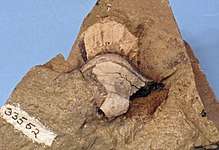Petalodus
Petalodus is an extinct genus of cartilaginous fish from the Pennsylvanian to the Permian,[6][7] known from subtriangular to rhomboidal teeth.[7] The genus was named by Richard Owen in 1840 and the type species is Petalodus hastingsii.[1][2][3][4] The only dubious species within this genus is P. securiger.[8][9]
| Petalodus | |
|---|---|
 | |
| P. ohioensis tooth | |
| Scientific classification | |
| Kingdom: | Animalia |
| Phylum: | Chordata |
| Class: | Chondrichthyes |
| Order: | †Petalodontiformes |
| Family: | †Petalodontidae |
| Genus: | †Petalodus Owen, 1840 |
| Type species | |
| †Petalodus hastingsii | |
| Other species | |
| |
| Synonyms | |
| |
Sources
- Report on the Geology of the County of Londonderry, and of Parts of Tyrone and Fermanagh. Memoirs of the Geological Survey of the United Kingdom, district mem. Geol. Surv. Ireland, Dublin, xxxi + 784 pp., A. Milliken, 1843, 784pp
- Petalodus hastingsii OWEN, 1840: In: Database of fossil elasmobranch teeth www.shark-references.com, World Wide Web electronic publication, Version 07/2020
- Case 3779 – Petalodus Owen, 1840 (Chondrichthyes, Petalodontiformes, Petalodontidae): proposed conservation of usage by designation of a neotype for its type species Petalodus hastingsii Owen, 1840. Bulletin of Zoological Nomenclature, 75: 241-246
- A synopsis of the classification of the British Palæozoic rocks, with a systematic description of the British Palæozoic fossils in the Geological museum of the University of Cambridge. In: Sedgwick, A. (ed), A synopsis of the classification of the British Palæozoic rocks, London :J.W. Parker and Son; [etc.] 1855.
- Halsey W. Miller, Jr.; Transactions of the Kansas Academy of Science (1903-) Vol. 60, No. 1 (Spring, 1957), pp. 82-85
- A. S. Woodward. 1889. Catalogue of the Fossil Fishes in the British Museum (Natural History) Part 1 1-613.
- Fossils (Smithsonian Handbooks) by David Ward (Page 198)
- Description of a new species of Petalodus (P. securiger) from the Carboniferous of Illinois. Journal of Geology, 3 (5): 561–564
- Handbook of Paleoichthyology, Vol. 3D: Chondrichthyes Paleozoic Elasmobranchii: Teeth Verlag Dr. Friedrich Pfeil, pp. 168, 154 fig., 4 Tab.
gollark: I can't figure out how to work followers, since those have their own UUIDs or something, but I can now update my own account's profile from the CLI.
gollark: I'm just trying to figure out how to automatically make my accounts follow me in case lyricly undoes it right now.
gollark: Yes.
gollark: How dare you destroy my followers like this‽‽‽
gollark: WRONG!
This article is issued from Wikipedia. The text is licensed under Creative Commons - Attribution - Sharealike. Additional terms may apply for the media files.